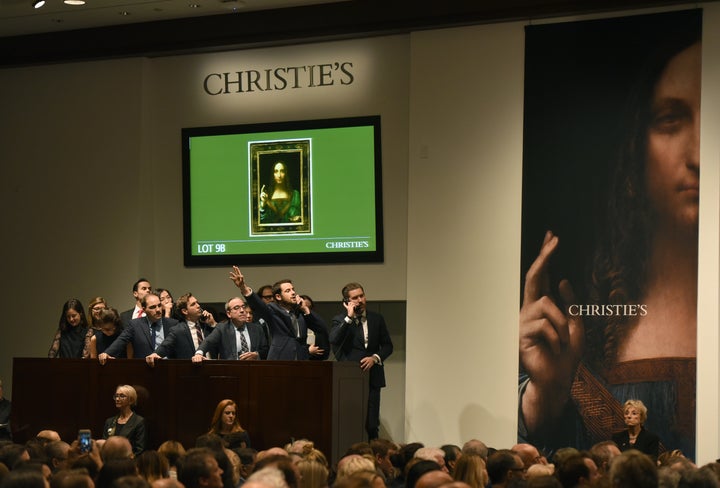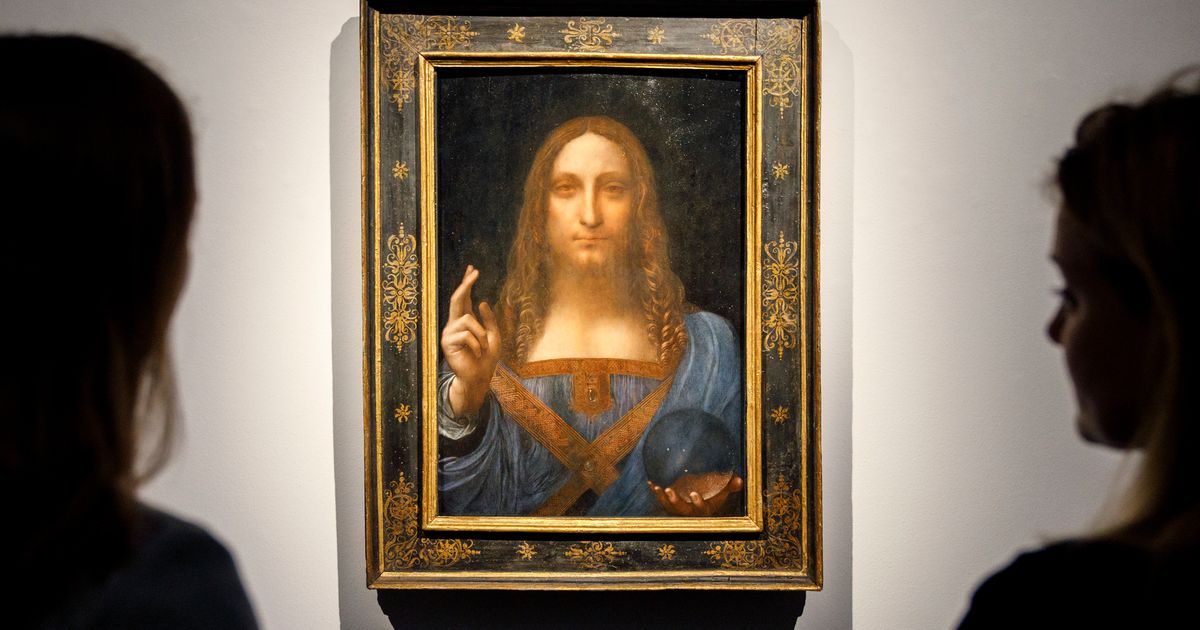Ahead of Wednesday’s record-breaking auction at Christie’s, during which a painting attributed to Leonardo da Vinci sold for a throat-clenching $450 million, art critic Jerry Saltz voiced some doubts.
Saltz, in an essay for New York magazine, called the portrait of Christ “dead” and “inert,” suggesting that the artwork ― which had been predicted to fetch only $100 million ― is “a sham.” It’s “no Leonardo,” he wrote. Saltz, neither a historian nor an expert in old master work, went on to suggest that Christie’s sale would end poorly. “No museum on Earth can afford an iffy picture like this at these prices.”
And then “Salvator Mundi (Savior of the World)” a 500-year-old portrait of Christ thought to be a copy when it was plucked from an estate sale for a measly $10,000 in 2005, sold for nearly half a billion dollars to an undisclosed private buyer. Suddenly, the controversy surrounding the painting’s authenticity ― its whereabouts over these last few centuries and whether multiple restorations had indelibly altered its surface ― became white noise. Christie’s had managed to rocket past previous auction benchmarks, brokering a historic sum for the seller, Russian billionaire Dmitry E. Rybolovlev’s family trust.
TOLGA AKMEN via Getty Images
Perhaps a museum lacked funds to secure the questionable picture, but a nameless member of the 1 percent surely possessed pockets deep enough.
To most people, $450 million is an unimaginable sum. As Hrag Vartanian at Hyperallergic pointed out, that’s more money than the total estimated cost of the new Whitney Museum of American Art in New York City: $422 million. (It’s also reportedly more money than the Koch brothers are expecting to spend in the 2018 election cycle: $300 million to $400 million.)
“This is a very small step for mankind, but a big step for the art market,” Frank Zöllner, a German art historian and professor at Universität Leipzig, who’s written a book on Leonardo, told HuffPost in a statement over email. “A heavily damaged painting by Leonardo, which was created with the substantial involvement of his workshop after 1507 or even later, achieved a record price, which is significantly higher than the sums that are called for modern masters.”
“Of course, [‘Salvator’] is the symbol of a very unequal, even obscene distribution of wealth in the world,” Zöllner added.

TIMOTHY A. CLARY via Getty Images
Art experts expressed concern with the $450 million price tag, well above the previous record for a painting sold at auction ― $179 million for Picasso’s “Les Femmes d’Alger,” set in 2015.
“I am deeply shocked by” the price, Stephen Campbell, an art history professor at Johns Hopkins University who focuses on Renaissance art, explained. “As a colleague said to me today, the 1 percent — who owns half the planet’s wealth — are looking for the last few places to deposit their wealth. This is a very limited, overvalued sector of the art market. … The pricing could be controlled in such a way that a public institution could afford it. This is not a celebratory moment.”
Campbell’s unease stems, in part, from the painting’s murky history, a pressure point for a portion of the scholarly community. Campbell saw “Salvator Mundi” in person six years ago. At the time, he was impressed by the lineup of experts willing to vouch for the work, as well as with the scrupulous condition report Christie’s released elucidating the painting’s entire conservation history. The report notes that X-rays and infrared reflectography revealed the signature pentimenti, or visible changes, that helped confirm the painting’s attribution.
“That being said,” Campbell continued, “there is very little Leonardo visible in the painting that was seen yesterday.”
Campbell estimated that only 20 percent of the painting’s surface was rendered in Leonardo’s 16th-century Italian workshop. The rest was carefully reconstructed by conservators, including Dianne Dwyer Modestini. And even that scant 20 percent is in question; there’s a possibility it was executed by Leonardo’s assistants, meticulously trained to mimic his style, and not by the old master himself. The true hand of the artist, Campbell said, is impossible to definitively discern.
“Most post-1500 [Leonardo] paintings are hybrids,” Campbell said. As a result, “when art historians say Leonardo, they’re talking about a category,” he explained. “It’s a ‘Leonardo effect.’”
Campbell is not the only historian with suspicions. Art adviser Todd Levin and Sotheby’s senior international specialist Philip Hook have also expressed measured doubt about the work and its provenance. The painting that once hung in the collection of Charles I of England now appears cracked and worn, overpainted and slightly reimagined. Its whereabouts from 1763 to 1900 are unknown. It resurfaced, only to be sold in 1958 for £45 and disappear once again ― until it popped up in 2005, courtesy of art dealer Alexander Parish. Between 2013 and 2017, the then-consortium-authenticated painting sold once for over $75 million, and again for $127.5 million.
“The attribution of this painting is hotly debated among Leonardo scholars and Renaissance art historians as it always happens with the discovery of new works by a major artist,” Francesca Fiorani, associate dean for the arts and humanities and professor of art history at the University of Virginia, told HuffPost. “Time will tell if the attribution of this panel to Leonardo will stick or whether in a few years the painting will look very different.”
In a statement to HuffPost, a representative for Christie’s cited Luke Syson, curator of Italian paintings before 1500 and head of research at the National Gallery in London; Keith Christiansen, chair of European paintings at the Metropolitan Museum of Art; Vincent Delieuvin, curator of 16th century Italian painting at the Musée du Louvre; and Martin Kemp, emeritus professor of the history of art at the University of Oxford, among others, as experts willing to endorse the work as Leonardo. Kemp reiterated his support of the attribution during a phone call with HuffPost on Thursday.
“There were some self-seeking publicity people, journalists, who tried to denigrate the painting, which was so expensive ― that was so valued. But they weren’t serious objections,” Kemp said. As evidence of Leonardo’s handiwork, Kemp homed in on several aspects of the work, including the mysterious orb that appears in Christ’s hand.
“It wasn’t like an ordinary sphere,” Kemp recalled of his time gazing at the painting in person. “It looked like rock crystal. … It’s not the normal ‘Mundi’ sphere. This is the sphere of the fixed stars, of the cosmos. So Leonardo transmuted it from being a savior of the world to being a savior of the cosmos. That’s the kind of genius he was capable of.”
As for the sum paid to secure the “Salvator,” Kemp agreed it’s “astonishing.” But the painting, which he described as the “spiritual equivalent to ‘Mona Lisa,’” is, he said, “worth what someone’s willing to pay for it.”
“The people who are paying these sums of money undoubtedly would have undertaken due research,” he added. “It is largely a restoration, and it is a damaged picture, but so are a lot of old master works. It’s not the best I’ve ever seen, and it’s not the worst.”
At the end of the day, Campbell concluded that the doubt surrounding the alleged Leonardo doesn’t matter, because, for all practical purposes, the attribution of the artwork was confirmed by the Christie’s sale.
“As a colleague of mine said, ‘Nothing makes a Leonardo more than a hundred- million-dollar price tag,’” Campbell said. “The valuation works in reverse to justify the attribution.” Ultimately, Campbell said that he could accept the painting as a Leonardo, but he could not reconcile with its price. “It’s become a trophy, a market fetish. It’s being taken away from the interest of scholars,” he said.
Lynn Catterson, a part-time lecturer at Columbia University who specializes in the Renaissance, the historical art market and 19th-century Florence, similarly described the painting’s value as “ridiculous and endemic to a planet whose economic disparities are worse than severe. And that is leaving aside issues of authenticity and provenance.”
As Tim Schneider wrote for Artnet News, Christie’s revised fee structure saddles buyers capable of purchasing works over $4 million with a 12.5-percent premium, which ultimately carried the final $400 million bid for “Salvator” to a total payout closer to the half-billion mark. For cultural institutions with limited budgets, the premium allows private buyers to outbid them at auction, leaving cultural touchstones in the hands of the ultra-rich.
This year’s Global Wealth Report, published on Tuesday, confirmed that 1 percent of the world’s population owns half the world’s total household wealth. Just as money has the power to shape democracy, so does it threaten to rewrite art history. If a seismic price tag becomes a more powerful indicator of masterworks than scholarly consensus, provenance and authentication, the sale sets a frightening precedent for, as Saltz put it, #FakeArtNews.
“Most people do not seem to realize that an attribution is an opinion and, as such, legally is not binding,” Maurizio Seracini, an art diagnostician who’s worked extensively with Leonardo’s work, said. “Nevertheless, investors are purchasing art at incredible prices based just on opinions! No wonder why the production of fakes is booming internationally!”
A $450 million valuation is then, by most accounts, unbelievable. However, if any artist could posthumously pull it off, Leonardo might be the most probable candidate.
“On one level, a staggering figure in the art market reminds me of global financial disparity,” Bronwen Wilson, a professor of Renaissance and early modern art at UCLA, said. “But I also find myself ruminating on Dan Brown, video games and lineups to see Leonardo’s works ― for the ‘Mona Lisa,’ ‘The Last Supper,’ and exhibitions ― which is to say that there is also something about Leonardo’s particular purchase on the cultural imagination that plays a role in this instance.”
The cult of Leonardo extends far and wide. He’s become the mythical manifestation of interdisciplinary genius, a superhuman amalgamation of artistic talent, scientific acumen and unbridled curiosity. And there is still another Leonardo work in private hands: “The Madonna of the Yarnwinder.”
As Campbell mentioned, it will be interesting to see what happens if and when this final masterpiece hits the auction block. Perhaps “Madonna” won’t match the hefty price tag of “Salvator,” suggesting soaring auction prices have reached their tipping point. However, if values continue to inflate, the art market’s steel bubble will continue to serve as a glorified piggy bank for the 1 percent.
This post has been updated to clarify the effect of Christie’s buyer’s premium.
